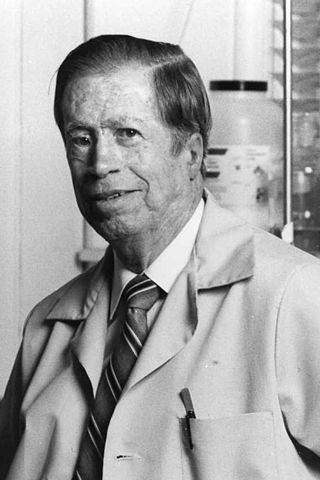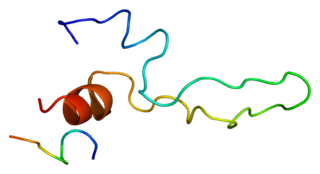
Proteolysis is the breakdown of proteins into smaller polypeptides or amino acids. Uncatalysed, the hydrolysis of peptide bonds is extremely slow, taking hundreds of years. Proteolysis is typically catalysed by cellular enzymes called proteases, but may also occur by intra-molecular digestion.
Combinatorial chemistry comprises chemical synthetic methods that make it possible to prepare a large number of compounds in a single process. These compound libraries can be made as mixtures, sets of individual compounds or chemical structures generated by computer software. Combinatorial chemistry can be used for the synthesis of small molecules and for peptides.
Choh Hao Li was a Chinese-born American biochemist who discovered, in 1966, that human pituitary growth hormone (somatotropin) consists of a chain of 256 amino acids. In 1970 he succeeded in synthesizing this hormone, the largest protein molecule synthesized up to that time.

Robert Bruce Merrifield was an American biochemist who won the Nobel Prize in Chemistry in 1984 for the invention of solid phase peptide synthesis.

In organic chemistry, peptide synthesis is the production of peptides, compounds where multiple amino acids are linked via amide bonds, also known as peptide bonds. Peptides are chemically synthesized by the condensation reaction of the carboxyl group of one amino acid to the amino group of another. Protecting group strategies are usually necessary to prevent undesirable side reactions with the various amino acid side chains. Chemical peptide synthesis most commonly starts at the carboxyl end of the peptide (C-terminus), and proceeds toward the amino-terminus (N-terminus). Protein biosynthesis in living organisms occurs in the opposite direction.
Xenobiology (XB) is a subfield of synthetic biology, the study of synthesizing and manipulating biological devices and systems. The name "xenobiology" derives from the Greek word xenos, which means "stranger, alien". Xenobiology is a form of biology that is not (yet) familiar to science and is not found in nature. In practice, it describes novel biological systems and biochemistries that differ from the canonical DNA–RNA-20 amino acid system. For example, instead of DNA or RNA, XB explores nucleic acid analogues, termed xeno nucleic acid (XNA) as information carriers. It also focuses on an expanded genetic code and the incorporation of non-proteinogenic amino acids into proteins.
Chemical biology is a scientific discipline between the fields of chemistry and biology. The discipline involves the application of chemical techniques, analysis, and often small molecules produced through synthetic chemistry, to the study and manipulation of biological systems. In contrast to biochemistry, which involves the study of the chemistry of biomolecules and regulation of biochemical pathways within and between cells, chemical biology deals with chemistry applied to biology.
Stephen B. H. Kent is a chemistry professor at the University of Chicago. While professor at the Scripps Research Institute in the early 1990s he pioneered modern ligation methods for the total chemical synthesis of proteins. He was the inventor of native chemical ligation together with his student Philip Dawson. His laboratory experimentally demonstrated the principle that chemical synthesis of a protein's polypeptide chain using mirror-image amino acids after folding results in a mirror-image protein molecule which, if an enzyme, will catalyze a chemical reaction with mirror-image stereospecificity. At the University of Chicago Kent and his junior colleagues pioneered the elucidation of protein structures by quasi-racemic & racemic crystallography.

The tert-butyloxycarbonyl protecting group or tert-butoxycarbonyl protecting group is a protecting group used in organic synthesis.
Melanocortin receptors are members of the rhodopsin family of 7-transmembrane G protein-coupled receptors.

Ronald T. Raines is an American chemical biologist. He is the Roger and Georges Firmenich Professor of Natural Products Chemistry at the Massachusetts Institute of Technology. He is known for using ideas and methods of physical organic chemistry to solve important problems in biology.
{{Infobox scientist | name = Max Bergmann | image = | caption = | birth_date = 12 February 1886 | birth_place = Fürth, Germany | nationality = | death_date = 7 November 1944 (aged 58) | death_place = New York City, United States | field = peptide chemistry | work_institution = Kaiser Wilhelm Institute for Leather Research
Rockefeller Institute for Medical Research | alma_mater = Ludwig Maximilian University of Munich, Friedrich Wilhelm University | doctoral_advisor = Ignaz Bloch | doctoral_students = Leonidas Zervas | known_for = Carboxybenzyl protecting group | spouse = Emmy Bergmann [[:de:Emmy Bergmann | children = Peter Bergmann (physicist) }} Max Bergmann was a Jewish-German biochemist. Together with Leonidas Zervas, the discoverer of the group, they were the first to use the carboxybenzyl protecting group for the synthesis of oligopeptides.

The Cholecystokinin A receptor is a human protein, also known as CCKAR or CCK1, with CCK1 now being the IUPHAR-recommended name.

Melanin-concentrating hormone receptor 2 (MCH2) also known as G-protein coupled receptor 145 (GPR145) is a protein that in humans is encoded by the MCHR2 gene.
Joseph Stewart Fruton, born Joseph Fruchtgarten, was a Polish-American biochemist and historian of science. His most significant scientific work involved synthetic peptides and their interactions with proteases; with his wife Sofia Simmonds he also published an influential textbook, General Biochemistry. From 1970 until his death, Fruton worked extensively on the history of science, particularly the history of biochemistry and molecular biology.

Klaus H. Hofmann was an American biological chemist and medical researcher. The New York Times called Hofmann an "expert on synthesis of body compounds". His career was highlighted by synthesis of a prototype birth control pill, isolation and structural characterization of biotin, determination of the lysine specificity of the pancreatic protease trypsin, the first chemical synthesis of a fully biologically-active portion of the peptide hormone, and structure-function studies on ribonuclease (RNase).

Nediljko "Ned" Budisa is a Croatian biochemist, professor and holder of the Tier 1 Canada Research Chair (CRC) for chemical synthetic biology at the University of Manitoba. As pioneer in the areas of genetic code engineering and chemical synthetic biology (Xenobiology), his research has a wide range of applications in biotechnology and engineering biology in general. Being highly interdisciplinary, it includes bioorganic and medical chemistry, structural biology, biophysics and molecular biotechnology as well as metabolic and biomaterial engineering. He is the author of the only textbook in his research field: “Engineering the genetic code: expanding the amino acid repertoire for the design of novel proteins”.

Günther Jung is a German chemist. He was professor for Organic Chemistry and Biochemistry at the University of Tübingen from 1973 to 2002.
Peptide therapeutics are peptides or polypeptides which are used to for the treatment of diseases. Naturally occurring peptides may serve as hormones, growth factors, neurotransmitters, ion channel ligands, and anti-infectives; peptide therapeutics mimic such functions. Peptide Therapeutics are seen as relatively safe and well-tolerated as peptides can be metabolized by the body.
Leonidas Zervas was a Greek organic chemist who made seminal contributions in peptide chemical synthesis. Together with his mentor Max Bergmann they laid the foundations for the field in 1932 with their major discovery, the Bergmann-Zervas carboxybenzoxy oligopeptide synthesis which remained unsurpassed in utility for the next two decades. The carboxybenzyl protecting group he discovered is often abbreviated Z in his honour.










